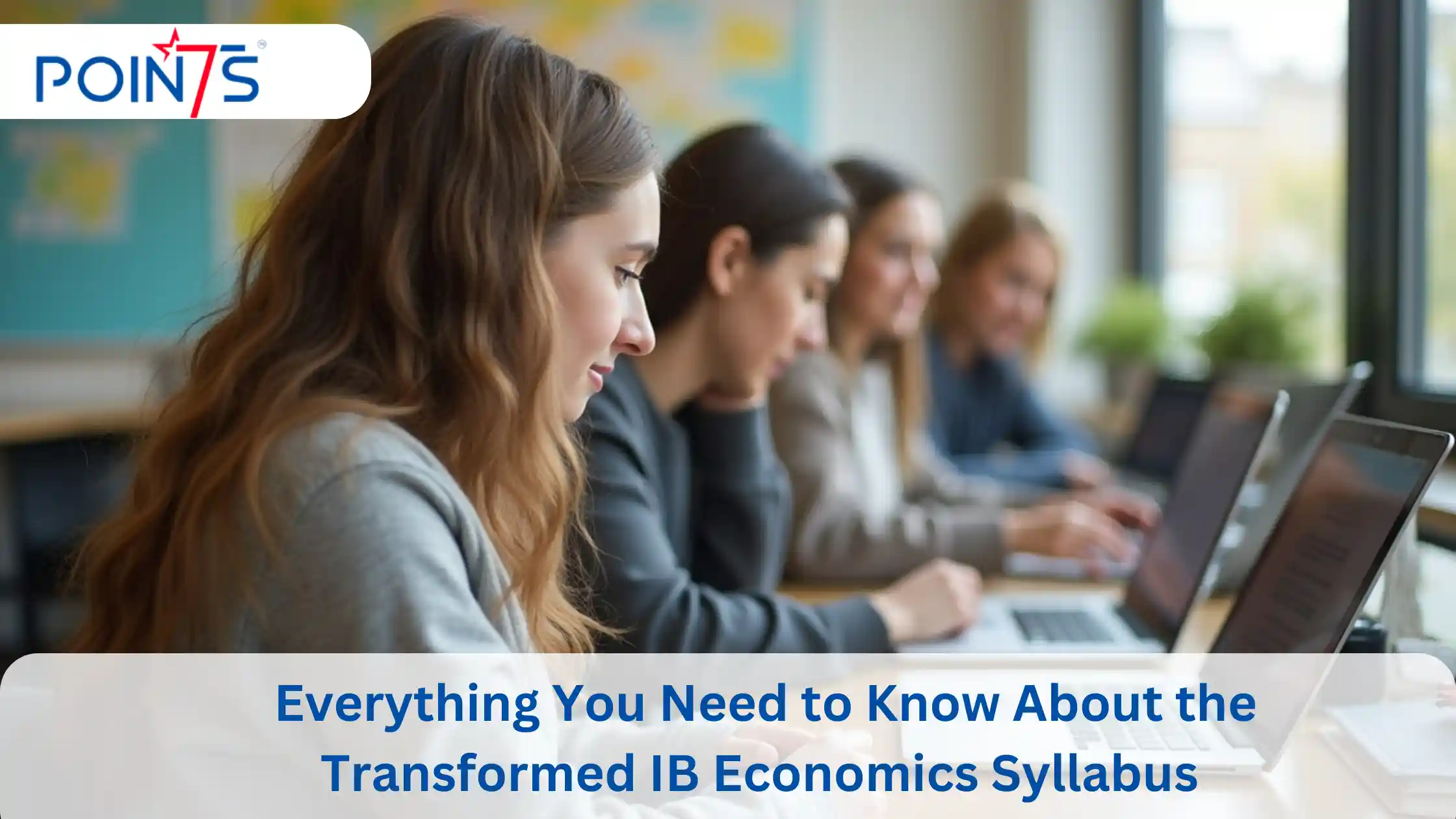The IB Economics curriculum has undergone its most significant transformation in years, and if you’re a student or parent navigating this change, you’re probably wondering what it all means for your academic journey. At Points Edulab, we’ve been working closely with students through this transition, and we’re here to break down exactly what’s changed, why it matters, and how you can turn these updates into opportunities for success.
Why the IB Decided to Completely Redesign Economics
The International Baccalaureate has always prided itself on preparing students for real-world challenges. Yet the previous Economics syllabus was a bit disconnected from the economic realities students would face beyond the classroom. Teachers and IB Tutors noticed that whilst students could recite theories perfectly, they often struggled to apply these concepts to actual economic situations happening around them.
The old curriculum leaned heavily on abstract models and theoretical frameworks. Students would learn about supply and demand curves, market structures, and macroeconomic policies, but the connection to contemporary issues like climate change, income inequality, or technological disruption remained tenuous at best. The redesign addresses this gap head-on by weaving real-world relevance into every aspect of the course.
This shift reflects a broader understanding within the IB community that economics education must prepare students not just to pass exams, but to think critically about the economic decisions shaping our world. The new syllabus treats economics as a living, breathing discipline that intersects with politics, environmental science, ethics, and technology.
Nine Fundamental Concepts That Change Everything
Perhaps the most revolutionary aspect of the new syllabus is its organisation around nine core concepts that function as analytical lenses throughout the entire course. These aren’t just vocabulary words to memorise—they’re thinking tools that students use to dissect economic phenomena from multiple angles.
Understanding Scarcity, Choice, and Efficiency
Scarcity remains the foundational concept of economics, but now students explore it beyond simple resource limitations. They examine how scarcity manifests in time, attention, environmental capacity, and even data privacy. This deeper treatment helps students understand why every economic decision involves trade-offs, not just in theory but in their daily lives.
Choice and efficiency work together to help students analyse how individuals, businesses, and governments allocate resources. Rather than treating efficiency as a purely mathematical concept, the syllabus encourages students to question what efficiency actually means. Efficient for whom? At what cost? These questions lead to richer, more nuanced economic thinking.
Exploring Equity and Economic Well-Being
Equity and economic well-being introduce explicit discussions about fairness and quality of life—topics that previous syllabi touched on only lightly. Students now critically examine whether economic growth translates to genuine improvements in people’s lives. They learn to distinguish between GDP figures and actual human welfare, understanding that a booming economy doesn’t automatically mean widespread prosperity.
Sustainability Takes Centre Stage
Sustainability has moved from a peripheral topic to a central organising principle. Students explore how economic systems can function within environmental limits, examining circular economy models, renewable resource management, and the true costs of consumption. This concept connects directly to the United Nations Sustainable Development Goals, giving students a framework for evaluating whether economic activities contribute to long-term viability or merely postpone future crises.
Change, Interdependence, and Intervention
Change, interdependence, and intervention round out the conceptual framework. Change helps students understand economic systems as dynamic rather than static. Interdependence highlights the intricate connections in our globalised economy, where decisions in one country ripple across continents. Intervention examines when and how governments should step into markets, pushing students beyond simple “free market versus regulation” debates into more sophisticated policy analysis.
What makes these concepts powerful is that they overlap and interact. An IB Economics Tutor might guide students through a case study on electric vehicle adoption, and students would naturally draw on sustainability, intervention (government subsidies), change (technological disruption), and interdependence (global supply chains for batteries). This integrated approach mirrors how real economists think about problems.
A Fresh Structure That Actually Makes Sense
The curriculum’s reorganisation into four distinct units creates a logical progression that builds student understanding systematically. The new structure flows in a way that feels intuitive rather than arbitrary.
Introduction to Economics
This foundational unit ensures every student develops solid grounding in fundamental principles before diving into specialised areas. It introduces the nine key concepts, basic economic thinking, and the tools economists use to analyse the world. Previously, students often jumped straight into microeconomics without this contextual foundation, which left some struggling to see the bigger picture.
Microeconomics with Real Human Behaviour
Microeconomics now integrates behavioural economics much more thoroughly. Students don’t just learn about rational actors making optimal choices—they explore how real people actually make decisions, including the biases, heuristics, and psychological factors that influence economic behaviour. This makes microeconomics feel less like abstract modelling and more like understanding actual human activity.
The unit examines market failures with greater depth, pushing students to think critically about when markets serve society well and when they don’t. Topics like information asymmetry, externalities, and public goods receive expanded treatment, with contemporary examples ranging from social media platforms to healthcare systems.
Macroeconomics in Action
Macroeconomics maintains its focus on aggregate economic activity but now emphasises the interconnections between different macroeconomic objectives. Students explore the trade-offs between growth, employment, price stability, and external balance in more sophisticated ways. The unit incorporates discussion of unconventional monetary policies, fiscal sustainability, and the limitations of traditional economic indicators.
Current events feature prominently here. Students might analyse how central banks responded to recent economic challenges, examining both the intended effects and unintended consequences of policy decisions. This approach transforms macroeconomics from a collection of theories into a toolkit for understanding economic news.
The Global Economy
This unit represents the most significant structural innovation. Previously scattered across different units, international economics now forms a cohesive whole. Students examine trade theory, exchange rates, balance of payments, economic integration, and development economics as interconnected topics rather than isolated concepts.
This unit particularly emphasises development challenges and sustainable growth paths for lower-income countries. Students critically evaluate whether traditional development models remain relevant in an era of climate change and technological transformation. They consider alternative measures of development beyond per capita income, including human development indices, inequality measures, and environmental indicators.
Assessment That Demands Real Understanding
The updated assessment structure rewards genuine economic thinking rather than memorisation. This shift has profound implications for how students need to prepare.
The Internal Assessment Gets a Complete Makeover
The Internal Assessment has undergone perhaps the most dramatic transformation. Students still write three commentaries based on news articles, but now each must explicitly link to one of the nine key concepts. This requirement forces students to move beyond simply describing what happened to analysing why it matters through a conceptual lens.
The word count hasn’t changed dramatically, but the assessment criteria have shifted decisively toward depth over breadth. A commentary that thoroughly explores one aspect of economic analysis will score higher than one that superficially covers multiple points. Students must demonstrate conceptual understanding, apply economic theory appropriately, and evaluate different perspectives with nuance.
For students working with IB Tutors, the IA represents an opportunity to showcase sophisticated economic thinking developed throughout the course. The best commentaries don’t just apply one concept—they show how multiple concepts interact in a real-world situation.
External Examinations Focus on Application
External examinations now place greater emphasis on data interpretation and policy analysis. Students receive economic data, statistics, charts, and policy proposals, then must analyse what the data reveals, identify limitations, and evaluate potential solutions. This format assesses whether students can actually do economics, not just recall what economists have said.
The questions often deliberately present ambiguous situations without clear “right” answers. Students must construct arguments, acknowledge trade-offs, and justify recommendations with evidence. This approach mirrors how professional economists work, where competing perspectives and incomplete information are the norm rather than the exception.
Higher Level Paper 3 Becomes Policy-Focused
Higher Level Paper 3 deserves special attention because it has transformed completely. The old quantitative paper tested mathematical skills in relative isolation. The new policy-focused paper embeds quantitative analysis within realistic policy scenarios. Students might receive data about a country’s economic performance, calculate specific indicators, then use those calculations to evaluate proposed policies and recommend alternatives.
This change reflects the reality that quantitative skills matter most when applied to meaningful questions. An IB Economics Tutor preparing HL students for Paper 3 will emphasise not just the mechanics of calculations but the interpretation and application of numerical results.
Weighting Changes Make IA More Important
Weighting changes make the Internal Assessment more important, particularly for Standard Level students, where it now comprises 30% of the final grade rather than 20%. This shift rewards sustained engagement with economics throughout the course rather than concentrating everything on final examinations.
Proven Strategies for Mastering the New Syllabus
Success in the updated curriculum requires approaches that align with its conceptual, applied nature. Students who adapt their study methods early will find themselves at a significant advantage.
Think Conceptually From Day One
Don’t treat the nine key concepts as separate topics to memorise. Instead, use them as analytical frameworks for everything you study. When learning about price controls, simultaneously consider efficiency (are resources allocated optimally?), equity (who benefits and who loses?), and intervention (why did government choose this policy?). This integrated thinking becomes natural with practice and dramatically deepens your understanding.
Immerse Yourself in Economic News
The syllabus demands that students connect theory to reality, which requires familiarity with real economic events. Read quality economic journalism regularly: The Economist, Financial Times, or reputable news sources covering economics and business. Don’t just passively consume these articles; actively analyse them using your economic toolkit.
When you encounter an article about trade tensions, ask yourself which concepts apply. Consider how different stakeholders experience the situation differently. Think about what data would help you evaluate the situation more completely. This active engagement transforms news reading from casual browsing into deliberate practice.
Develop Sophistication with Data
The emphasis on data interpretation means students need comfort working with statistics, charts, and economic indicators. Practice extracting insights from data presentations. Learn to identify trends, spot anomalies, and recognise what data doesn’t tell you as well as what it does.
Equally important is developing healthy scepticism about data. Question how indicators are constructed, what they measure and don’t measure, and whose interests particular presentations might serve. This critical approach to data will serve you well beyond IB Economics.
Master the Art of Economic Evaluation
The highest marks consistently go to students who can evaluate—weighing different perspectives, acknowledging trade-offs, and making nuanced judgments. Simply describing economic theory or applying it mechanically won’t suffice. You need to develop the habit of asking “compared to what?” and “at what cost?” about every economic situation.
Practice writing conclusions that synthesise different considerations rather than simply listing points. Strong evaluation recognises that economic policies create winners and losers, that short-term and long-term effects may differ, and that context profoundly shapes outcomes.
Collaborate with Peers and Seek Expert Guidance
Economics becomes richer through discussion and debate. Form study groups where you can discuss real-world examples, challenge each other’s assumptions, and practice explaining concepts. Teaching something to someone else remains one of the most effective ways to cement your own understanding.
Working with experienced IB Economics Tutors who thoroughly understand the new assessment criteria and conceptual approach provides invaluable insights. They can identify gaps in your understanding, suggest stronger ways to analyse issues, and help you develop the sophisticated economic thinking that earns top marks.
How Points Edulab Prepares Students for Excellence
At Points Edulab, we’ve aligned our entire approach with the demands and opportunities of the transformed syllabus. We recognise that effective IB Economics tutoring now requires more than content knowledge, it demands deep familiarity with conceptual thinking, assessment criteria, and applied analysis.
Expert Tutors Who Understand the Changes
Our tutors bring extensive experience with the updated curriculum and have worked with numerous students through the transition. They understand precisely what examiners look for in responses and can provide targeted feedback that improves performance efficiently. More importantly, they model the kind of economic thinking students need to develop—questioning, analytical, evidence-based, and nuanced.
Conceptual Understanding Over Surface Coverage
We prioritise conceptual understanding over superficial coverage. Rather than racing through topics, we ensure students grasp core concepts deeply enough to apply them flexibly across different contexts. This approach builds confidence and competence simultaneously.
Personalised Attention for Individual Needs
Personalised attention forms the foundation of our teaching philosophy. We recognise that each student brings different strengths, challenges, and learning styles. Some students need help structuring their analysis, others struggle with data interpretation, and still others require support developing evaluation skills. Our sessions adapt to individual needs rather than following a one-size-fits-all curriculum.
Comprehensive Internal Assessment Support
For Internal Assessment, we provide comprehensive guidance from article selection through final commentary revision. We help students identify articles rich in economic content, develop clear conceptual links, structure their analysis effectively, and polish their writing. Our feedback focuses on developing students’ own thinking rather than simply correcting errors.
Results That Matter
Our result-oriented approach means we focus relentlessly on meaningful improvement. We track progress, identify areas needing additional attention, and adjust our methods to ensure students reach their goals efficiently. This approach respects both student effort and family investment by maximising outcomes.
Beyond immediate exam preparation, we aim to instil genuine economic literacy—the ability to understand economic news, evaluate policy debates, and think critically about economic claims. These capabilities serve students long after they receive their IB results.
Making the Transition Work for You
The updated IB Economics syllabus represents a genuine improvement in how economics education prepares students for understanding and engaging with the world. By embracing these changes early, understanding what they demand, and preparing strategically, students can excel academically whilst building capabilities that extend far beyond the classroom. Whether you’re just beginning your IB Economics journey or midway through the course, the right approach and support make all the difference.
Faqs
The most significant change is the shift to a conceptual approach built around nine key concepts. Rather than learning economics as disconnected topics, students now use concepts like sustainability, equity, and interdependence as analytical tools across all units. The syllabus also places much greater emphasis on real-world application and current economic issues.
Each of your three commentaries must now explicitly link to one of the nine key concepts. The assessment criteria heavily reward depth of analysis and conceptual understanding rather than simple description. The IA also carries more weight 30% for Standard Level students compared to the previous 20%.
Paper 3 has completely transformed from a purely quantitative test to a policy-focused examination. You’ll still need strong quantitative skills, but now you apply them within realistic policy scenarios. You might calculate economic indicators and then use those calculations to evaluate proposed policies and recommend alternatives.
Yes, the syllabus integrates several contemporary issues that received minimal attention previously. Behavioural economics, income inequality, poverty, technological change, and sustainability are now woven throughout the course. The Global Economy unit also brings together international topics that were previously scattered.
Focus on developing analytical and evaluative skills rather than memorising content. Practice working with economic data, reading current economic news, and linking articles to key concepts. Old past papers won’t fully prepare you for the new format, so work with updated practice materials and seek guidance from IB Tutors familiar with the changes.
It’s different rather than objectively harder or easier. Students who enjoy connecting theory to real-world issues and thinking conceptually often find the new syllabus more engaging and accessible. Those who preferred memorising theories might need to adjust their approach. The key is understanding early what the syllabus demands and preparing accordingly.




